Text
the sea is a terrible place (or: here's some scary natural phenomena found in the sea of Siren)
The false reflection, mostly encountered by deep-diving phocids. This phenomenon occurs when ultra dense high saline water gathers in underwater brine pools on the sea floor. It appears reflective, like a mirror. Down in the deep, the only way you can see at all is to take some form of luminescence with you, which obscures the pool and shows you nothing but another phocid below, holding a light source. It's common for pelagic people to be unfamiliar with their own facial markings and reflection. They mistake the reflection as another phocid, or a ghostly apparition, and reach out. But the salinity of the brine pool is such that even touching it can scald the skin, especially as all mammals on siren are adapted to low salt conditions and require far far less salt than unaltered humans.
The abyss, of course. Most of the sea of Siren is not as deep on average as the sea on Earth. But there are cracks and trenches in the sea floor that go down, and down, and down... they are poorly explored (though the first settlers did send drones down) and sites of myth and legend for swimmers. The abyss is not usually dangerous, since it's easy to just not go down there, but sometimes the cracks seem to inhale and exhale - natural flows of groundwater, or attempts to fill a vacuum caused by a different crack releasing gas. So swimming over certain cracks might result in you being dragged down unexpectedly into the anoxic zone near the sea floor in the region... or it might result in you being unexpectedly shot up. These events are incredibly rare and usually passed off as tall tales, some selkie who claims to have flown due to being propelled into the sky
The snowstorm... an event that occurs when the sediment is agitated enough to completely white out the water. If the particles are the right size, echolocation clicks bounce back immediately, making sight and echo useless. Phocids and selkies trapped in the snowstorm could lose situational awareness and forget which way is up very easily, and the instant bounce-back of echo clicks is deeply unpleasant, giving the illusion of being 1 inch from swimming straight into a solid wall.
Shriekers. This is an issue where ice caps, glaciers etc meet the water. The ice cracks and breaks, and to sensitive phocid and selkie ears it's an unbearable shriek that can render them disoriented and deaf at long range, and break eardrums at close range. Around the ice wall, there's an almost constant background noise of screaming.
The false sky. A phenomenon that occurs when a swimmer loses situational awareness, and ends up diving deeper and deeper thinking that they're about to come up for air. The reduced gravity of siren means that it's more difficult under the water to feel gravity, resulting in a more weightless sensation than on Earth. Occasionally, a natural biolumescence in deep water may produce an illusion of the sky viewed through the turbid water, making the disoriented swimmers even more certain that they are travelling up, when really they are diving. In Spiral mythos this is treated as a specific type of mania.
The wanderer.. it looks like a phocid swimming in the distance. You hail them, click at them, wave your lantern, but they don't respond. If you get closer, they'll flee. This is a really common story among nearly all pelagic people worldwide, and what they are seeing are the vanishingly rare aquatic zeta, those who did not adapt to becoming terrestrial and became extremely solitary, so they were not able to regain language due to not having complex cultures and societies anymore. They resemble smaller, hairy phocids and are considered a type of (for lack of a better word?) fairy or trickster spirit in Spiral culture, a false friend leading you astray.
The flesh cloud. This is a mass of deceased scalefish, the hagfish-like animals which make up many of the fish shoals on Siren. If they enter an anoxic zone unexpectedly (if chased, pushed by currents, or just unlucky) they can die in large numbers, forming a tangled, decaying mass that drifts through the seas. These are heralds of rot and disease and the water around them is filthy and unclean, an infection risk for any swimmer with an open cut. Sometimes large nets are set up to catch and redirect them.
Sharp sand. Some substrate is made of silica and appears glittery, like fairy dust. When water mixes, these can form plumes which are hundreds of feet tall. They're not dangerous in and of themselves, but you had better make sure you close your eyes around it, no matter how pretty the dancing glitter might be. A common cause of corneal ulceration and abrasion.
Cherta's Tide. This is a big one. Tides are slow and rare most of the time, mixing the water and enabling life to flourish. But every so often, there are two different tides that come round, which can be predicted based on which moon is most prominent in the sky for the duration. Ishmael's Tide is a high water apocalyptic event, but there are many monitoring stations and contingencies to avoid it. Cherta's Tide (similar to a neap tide) is far more unpredictable and occurs irregularly, as the moon Cherta is smaller, darker, and harder to see. This tide is a low-water event. Vast stretches of the sea floor are laid bare and the underwater ridges suddenly become towering cliffs and barriers for people who can't fly. This can last for weeks at a time, and without the water of course most animal populations who can't hide in substrate take a huge hit. It can happen fast enough to strand a swimmer at the top of a ridge, nothing but air below all the way to what was once the sea floor, and they might be stranded, unreachable, and without food or water for a fatal period of time.
129 notes
·
View notes
Text
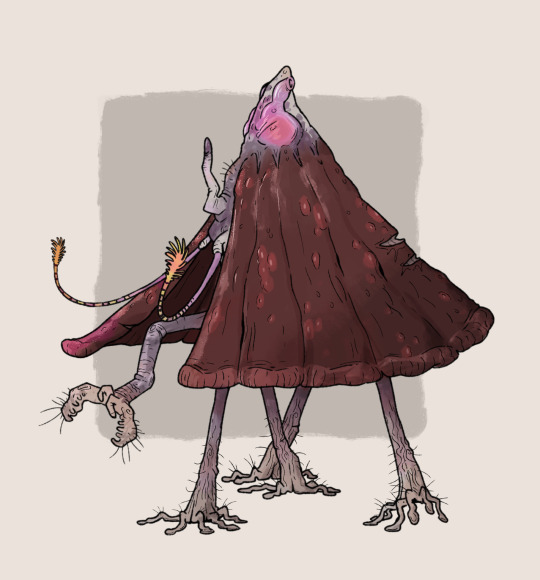
The Crone's Mantle
Traipsing through the marshy lowlands of Western Altamira's south, one may come across an unusual member of the pentapoda, colloquially known as the Crone's Mantle.
This shallow-water specialist, standing 7 feet tall at the peak, spends the warm months similarly to most large pentapods, feeding on water plants and drawing much of its energy from the sun. Come the shorter days of the cold season, however, the Mantle seeks a different source of energy.
Conserving what limited energy it can draw from sunlight during the short days, the Mantle roots itself in place along shallow stretches of rivers and streams. Its unusual downturned sails create shade that attract small squilloids, which, upon sensing the movement with its bristly legs, are snatched out of the water with its anterior appendage and flung into the Mantle's ventral mouth.
The Mantle shares its home with a variety of semiaquatic rasps, wading terrestrial squilloids and - most notably - predatory grapplers. The slow-moving Mantle defends itself with loud trumpeting from two respiratory organs atop its conical back, and if that's not enough, its ventral sails secrete a foul-tasting oil that deters most predators.
Hopefully not too late @simon-roy
57 notes
·
View notes
Text
Oh, the Crocus is a pom-pom goldfish, and the Zinnia is a celestial goldfish!
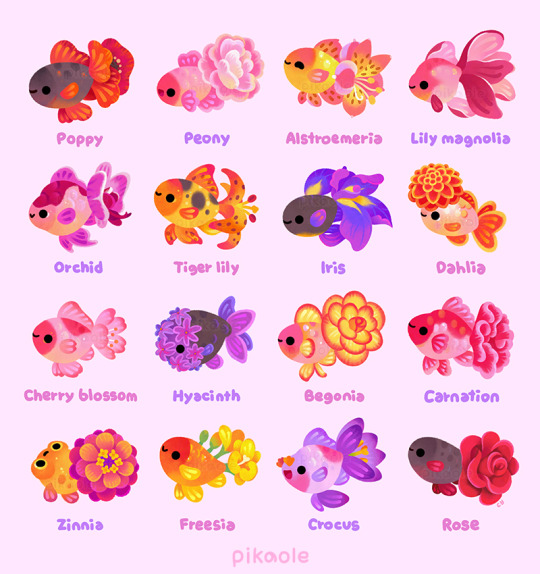
Flower goldfish
[ Patreon / galaxy themes / insta / S6 / RB shop ]
977 notes
·
View notes
Text
The beauty…

Bellsprout line variant inspired by the cobra lily, a pitcher plant native to California.
#fakemon#pokemon#pokemon variations#pokemon fanart#pokemon art#pokemon variant#bellsprout#weepinbell#victreebel#cobra lily#carnivourousplant
374 notes
·
View notes
Text

Hey everybody, go check out @simon-roy 's new book Refugium on Kickstarter! If Simon's reputation on its own somehow isn't enough to convince you to back it, there's a whole mini specbio guidebook with entries from me and like a ton of your other favorite artists probably.

Here are my little aliens without the text and weathered effects
629 notes
·
View notes
Text



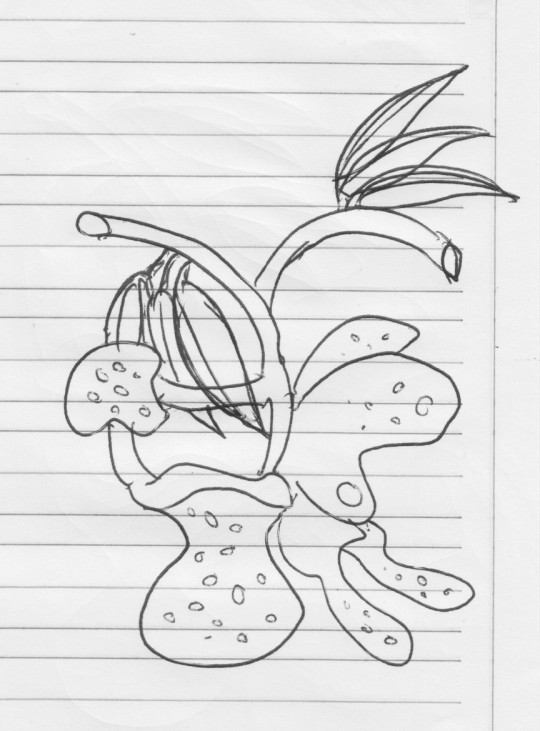

Coryanthes Nepenthes
1 note
·
View note
Text
One change I would implement in Pokemon games is removing Synthesis from the movepool of all mushroom Pokemon.
Instead, they would learn Moonlight.
174 notes
·
View notes
Text
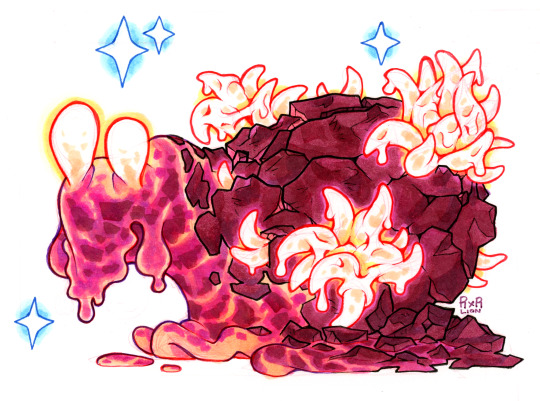
Shiny Magcargo
951 notes
·
View notes
Text

My greatest concept: Nepenthes pitcher-plant inside the pitcher of a bigger Nepenthes that is also a living aquarium.
5 notes
·
View notes
Text

Banded Orange Lichen Moth (Wittasura lineatus), family Erebidae, Ubud, Bali, Indonesia
photograph by Marcel Silvius
477 notes
·
View notes
Text
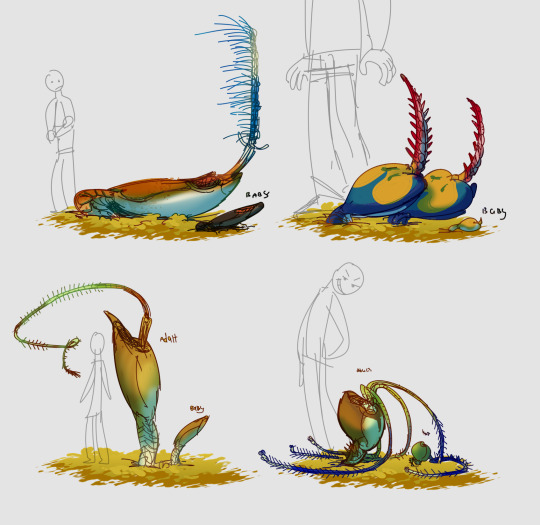
Slankats
Slankats are a wide group of Sinedenian parasitic heliophytes, most often found in areas with particularly thick foam grass layers which they parasitize on. It is the main host for the most slankats, although there are some exceptions.
This group of mixotrophs especially stands out from the rest, having a more animal-like appearance rather than the usual plant-like body plan. Some might confuse them with barnacles, due to their segmented tail and valved body with a feathery appendage.
They are highly specialized for parasitic lifestyle, to the point that some of them cannot produce their own nutrients by photosynthesis at all.
General anatomy of slankats
Their large bodies, despite their visual bulk, are actually very light and contain only a small number of tubular organs as well as a cavity for folding the stem into it. They attach to their hosts with the help of a scaly tail, at the end of which there is a spiked anchor with the bases of root organs on the sides. The roots of slankats are thin, long and highly branched, which allows them to absorb as many nutrients as possible from the foam grass.
At the top of the body there is a gill plate, with the help of which slankats breathe. Next to it there is a hole, from which emerges a flexible stem with genital organs growing on it (whip-flowers and chains of fruits).
The number of whips differs for different types of slankats (from 1 to 10). These whips carry female and male reproductive cells and unction similar to flowers on earth. When the whips are pollinated, after some time they wither away and in their place the fruits begin to grow, the number of which also varies. They can grow either in a chain or in a kind of bouquet.
Slancat fruits carry from two to ten embryos, and the fruit also contains chambers of gas that allow the fruit to fly away on wind currents or float on the surface of the water during floods (depending on the species, breeding cycle and season). When the fruit gets carried away to a fitting place, embryos emerge by popping out of the husk of the froot and then borrow into their host by using their tails.
155 notes
·
View notes
Text
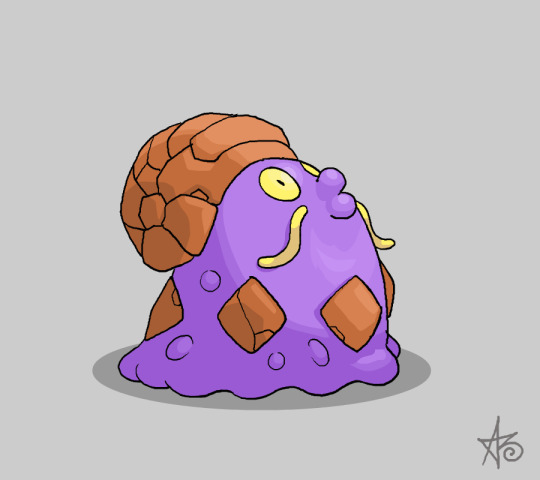
Ko-fi Dooble
Royal Tyrian Purple: Swalot + Shiny Magcargo
32 notes
·
View notes
Text

My greatest concept: Nepenthes pitcher-plant inside the pitcher of a bigger Nepenthes that is also a living aquarium.
5 notes
·
View notes
Text

My greatest concept: Nepenthes pitcher-plant inside the pitcher of a bigger Nepenthes that is also a living aquarium.
5 notes
·
View notes
Text

Gloom OBF 198 Illustration Rare by Masako Tomii from Scarlet & Violet—Obsidian Flames
711 notes
·
View notes
Text
Gotta put this on my watch list then.
Watched Scavengers Reign. It's so rare to see something where animation itself is equated to life itself. It's the absolute best of Nausicaa yet even more imaginative and lovingly animated. Every creature and object is presented so naturalistically that despite how fantastical the world was, I always believed in it. Stunning
961 notes
·
View notes
